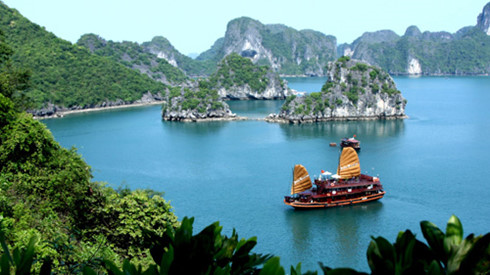Flailing foreign arrivals show depth of tourism shortfalls
 |
At first blush, official statistics seemingly show the industry has experienced solid year-on-year growth in terms of foreign arrivals, having jumped 24% to 5.5 million for the seven months through July 2016.
But a closer examination reveals that the numbers for the corresponding seven month periods in 2015 and 2014 had fallen by 9.4% and 14.2% respectively, for an overall combined drop of 23.6%.
Simply put, the number of international arrivals for the first seven months of 2016 is that same as it was for the same seven-month period in 2013 and there has been zero overall growth for the intervening period.
To add insult to injury, noted one leader at the conference, 70% of tourists that do visit Vietnam never return.
Many at the conference blamed the low return rate on crime, traffic congestion, poor service, lack of hygienic toilets and environmental pollution, among other things, but no one had a clear and concise explanation for it.
Another leader in attendance pointed out that according to a World Economic Forum Travel and Tourism Competitiveness Report for 2015, Vietnam ranked No. 75 out of 141 countries in overall tourism competitiveness.
Pollution of beaches and other tourism destinations was cited by the report as the leading shortcoming of tourism in the country in addition to an array of other items such as complicated visa policy and lack of support for tourists.
Prime Minister Nguyen Xuan Phuc along with leaders from the 63 municipal governments were in attendance at the meeting.
Nguyen Duc Chung, chair of the Hanoi municipal government complained about the difficulties in marketing to international tourists. Hanoi’s marketing strategies are not adequately conceived or planned and lack an appropriate mix of activities that appeal to the typical foreign traveller from the EU.
Neither the governmental nor private industry staff working in the segment have an acute understanding of international consumer needs, motivations and varying travel styles, as well as language, cultural and culinary requirements.
He emphasized that without this base level of knowledge developing a tourism product that’s appealing to EU travellers’ international standard just isn’t an achievable objective.
Coordination of tourism activities between the various levels of government is also far too weak, he noted.
Nguyen Thanh Phong, chair of Ho Chi Minh City, agreed, acknowledging that the number of arrivals has taken a beating over recent years. Management of tourism in the City has fallen far short of expectations and is not meeting with foreign travellers’ expectations.
Deputy Prime Minister Vuong Dinh Hue said the tourism segment needs to be overhauled and restructured to improve capacity, services and products, adding that the nation is currently in need of money and fresh ideas to accomplish the task.
Meanwhile Huynh Duc Tho, chair of Danang reports that its tourism is being negatively affected by too many abandoned investment projects.
We currently have too many hotels and resorts and must re-evaluate our plans going forward. Access to public beaches is being blocked as a result, which has a serious negative impact on international tourism. Maybe we need to adjust our focus to community tourism.
The city currently has 14 either lagging or abandoned projects blocking access to large areas of coastal lands all the while creating an eyesore for all the world to see.
Heads of the agencies have clearly authorized the issuance of permits to projects that were not properly vetted and now the tourism industry is suffering from those poor decisions.

